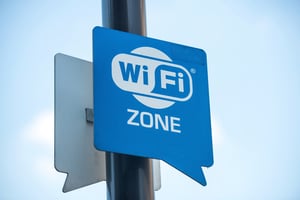Time to Read: 10 minutes
Hearing aids are little technological marvels. They have built in computer chips and sophisticated programming designed to maximise your best hearing.
When teamed with smart phones, hearing aids offer a range of additional benefits that go beyond simply better hearing.
The connection between your hearing aids and your smart phone is Bluetooth.
The first and most important thing to note is that Bluetooth-enabled hearing aids work as hearing aids first and foremost.
- Bluetooth is an accessory, a nice-to-have feature
- Your hearing aid is completely independent of Bluetooth
- Your hearing aids DO NOT need Bluetooth to work effectively as hearing aids.
 What is Bluetooth?
What is Bluetooth?
Bluetooth is a standard for the short-range wireless interconnection of mobile phones, computers, and other electronic devices.
It operates on a radio frequency - 2.4GHz, which is the frequency assigned for wireless and cordless communication products. It is designed to work over distances of about 8-10 metres.
It should not be confused with WIFI. The easiest way to remember this difference is:
- Bluetooth - connects wireless devices to each another
- WIFI - connects wireless devices to the Internet
The advantage of Bluetooth is the convenience of ‘wire free’ access to various technology. The types of devices that are Bluetooth-enabled are many and varied:
- Headsets for listening to your favourite music in private.
- Smart watch for tracking your fitness (or even taking phone calls like the 1930s comic book detective, Dick Tracy).
- External speakers for listening to your favourite music around the house
- Bathroom scales - yes, bathroom scales that will transmit your weight and body mass index direct to an app on your phone.
- Door bells (which can also have a camera) - ‘Ding Dong, Avon calling!’... or is it? Wireless door bells with audio and video connection employ Bluetooth and WIFI to transmit to your phone so you can answer your front door even when you’re not home.
- Selfie sticks - to attach to your smartphone as you practice your trout pout and sharpen your Instagram A-game.
- Computer keyboards and mouses (and that is correct - the plural of a computer mouse is mouses, not mice. We save that word for the little furry creatures)
And the list is growing.
Hearing Aid manufacturers have long looked at Bluetooth and how it could be used to add greater value and convenience to hearing aid wearers. The big drawback was concern about the power drain.
Apple was the first to overcome the problem. The early adopters among the hearing aid manufacturers created hearing aids that would stream audio only from iPhones. At the beginning of 2019, Phonak released the Marvel which offers direct Bluetooth streaming ability to both Apple and Android products.
Let’s look at the things you can do with a Bluetooth hearing aid:
- Stream phone calls directly into your hearing aids.
- Stream music, movie soundtracks or podcasts directly in stereo (mono if you are only using one aid) into your hearing aids.
- Use your phone as a remote microphone for your hearing aids.
- Get your hearing aids adjusted remotely by your clinician via your recent version Smart Phone.
- With the use of a proprietary Bluetooth stereo transmitter, get your television audio in your hearing aids directly and in stereo if two aids are used.
- Use Bluetooth accessories, such as remote microphones to hear a person from across a room or across a table (no more than 10-15 metres away).
- Use smart apps on your compatible smart phone, to function as an artificial assistant, connect the aid to your smart home, get your phone calls transcribed to text in real time, invoke artificial learning and much more (Note: not all features available in all devices).
Understanding terminology: Bluetooth, WIFI and Smart Phones

For the majority of our clients, the major attraction of these marvelous devices are the ability to receive phone calls directly in the ear. This means getting a better understanding of their smart phone.
Some clients get confused between WIFI and Bluetooth. That's not a surprise because smart phones contain three wireless connections:
- Bluetooth connections - Bluetooth is a direct ‘device-to-device technology’. That means you have to actively “pair” the two devices being linked. Bluetooth has also been described as acting like a cord between the two devices by creating a secure, wireless personal area network in which these devices can communicate.
- Cellular connections - remember the days when your mobile phone could only be used for making phone calls? Now the signal can be used to transmit data as well as voice. We’re now up to the fifth generation of this technology abbreviated as 5G.
- WIFI connections - you don’t need to use up your mobile phone’s data to access the internet or enjoy the convenience of the apps. Your phone can get onto the Internet using someone else’s connection to the Internet. You’ll find this in places like hotels, airports, shopping centres and cafes. Some councils offer WIFI in malls and parks. You will need to sign in to use it.
To add to all the complexity, not all smart phones are equally ‘smart’.
The three main smart phone brands are Apple, Samsung and Windows - and they each use different operating systems.
Apple and Windows, run on proprietary operating systems - that is, only an iPhone will have iOS and only a Windows phone will use the Microsoft Windows operating system.
Samsung phones use an operating system called Android. Unlike Apple and Windows, Android is open source software which means that any manufacturer can build a smart phone to using the Android platform.
Major companies using Android include: Sony Xperia, Google Pixel, Nokia, HTC, Samsung, LG, Huawei.
Smart phones also vary in price. Many people choose to bundle the price of the phone with a telco - such as Optus, Vodafone and Telstra and go on a plan.
Other people choose to purchase their own phone outright or are looking for a cheap replacement for a damaged phone. However not all smart phones are equal. Some phones have an older generation Bluetooth protocol or have a cheaper computer processors which may result in apps not working or issues in keeping devices connected to Bluetooth.
Frustrations with Bluetooth hearing aids
 Having trouble with your Bluetooth hearing aids?
Having trouble with your Bluetooth hearing aids?
It may not be your hearing aids. It might be your phone.
As we covered earlier in this article, Bluetooth hearing aids do not need to be connected to a smart phone for them to work.
Understandably many people are upset when their hearing aids lose connection with Bluetooth. More concerning is people believing their hearing aid failed if they are not receiving calls through their aids.
We conducted a survey of our Value Hearing clinicians and support team and they came up with the top eight list:
- Call quality
- Connectivity issues
- App Drop outs
- Pairing issues
- Switching between devices
- Range issues
- Phone compatibility
- Thinks aid doesn't work when Bluetooth intermittent
Over the next two months we’re going to go through each issue in depth.
How do you know if your smart phone is up to the task?
Check with your manufacturer’s web site. Many of them have a list of phone makes and models their hearing aids support.
Unitron
- https://www.unitron.com/au/en_au/help-and-support.html
Widex
- https://global.widex.com/en/support/com-dex/compatibility
Resound
- https://www.resound.com/en-au/help/compatibility
Signia
- https://www.signia-pro.com.au/direct-streaming/
Phonak
- https://www.phonak.com/au/en/support/faq/bluetooth/general-phone-faq.html
- https://www.phonak.com/au/en/support/faq/bluetooth/android-faq.html
Oticon
- https://www.oticon.com/support/how-to/opn-wireless-connections/faq
- https://www.oticon.com/support/compatibility